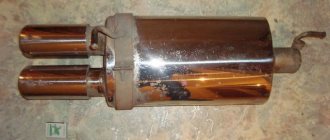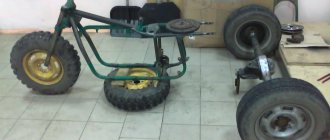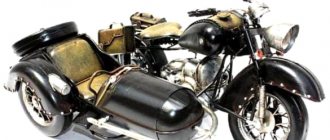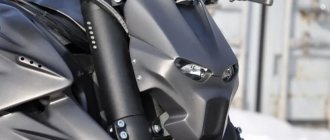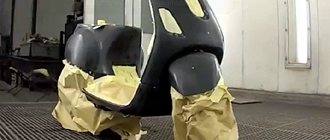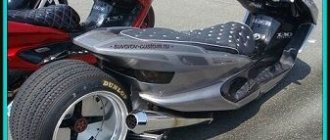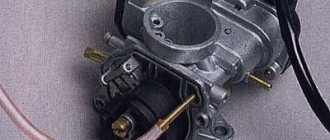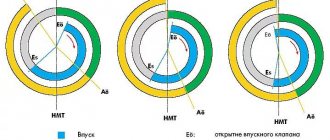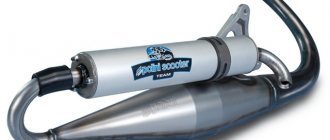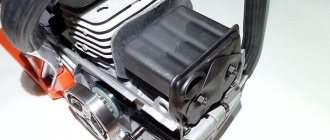How to make a quiet muffler on a car - tuning the silence
Only a small part of car enthusiasts would like to have a loud sports exhaust on their car. The vast majority of drivers, on the contrary, are puzzled by the question of how to make a quiet muffler. Driving can be comfortable only if as little extraneous sounds as possible enter the cabin. The muffler creates its own background noise, which can be significantly reduced. The effect of this cannot be ignored.
Basic ways to make a muffler quieter
Before you begin upgrading your exhaust system, you should understand the nature of the increased exhaust sound. With each working stroke of the piston, a micro-explosion occurs in the combustion chamber of the engine cylinder, which is accompanied by a significant sharp expansion of gases. Naturally, a kind of blast wave, after it has done its job and moved the piston down, rushes through the exhaust system with the opening of the exhaust valve.
Thus, the nature of exhaust system noise is twofold:
- sound from expansion of gases;
- noise from vibration of exhaust system elements.
As you know, the main way to combat noise is to increase the weight of the elements. The thicker the metal, the less vibration and, accordingly, noise. That is why the exhaust manifold, which is the first to absorb hot gases from the cylinder head, is made so massive. Many car enthusiasts who had the opportunity to compare the weight of the exhaust pipe of a domestic car and a foreign one noted that the exhaust system parts of foreign cars are much heavier. This is why “our” cars are less comfortable in sound and noise comparisons.
Special elements are designed to reduce the speed of gas movement in the exhaust pipe: resonators and mufflers. First in line is the resonator. As soon as gases under pressure enter a part of the pipe with an increased volume, they immediately lose some of their energy and move further with less momentum. In the muffler labyrinth system, the exhaust gases finally lose their energy and are dissipated. A real quiet muffler on a foreign car is quite heavy and has several separate housings.
Do-it-yourself quiet muffler, video:
Making a quiet muffler with your own hands
When starting to modernize the exhaust system in order to reduce exhaust sound, you should be prepared technically and financially. For work you will need a full set of car mechanic tools. In addition, you will definitely need:
- welding machine (preferably semi-automatic or inverter);
- angle grinder with a set of discs;
- a workbench equipped with a vice.
One of the most affordable ways to get a quiet muffler in the average garage is to include an additional resonator in the existing exhaust system.
There are also two options for upgrading the exhaust system: installing an additional factory-made resonator in the area between the main resonator and the muffler, or making the device yourself.
When considering how to make a muffler quieter, it should be borne in mind that any of the options may entail different costs. If the car enthusiast is not limited by budget, then you can safely buy a new resonator, cut out part of the pipe and weld it into the free space. The second method turns out to be more exciting and should be described in more detail.
The manufacturing technology of an additional resonator consists of the following stages:
- manufacturing a body (barrel) from a piece of thin-walled steel pipe or sheet steel in the form of two halves;
- making holes in a section of the exhaust system pipe corresponding to the length of the body behind the main resonator;
- connecting the body halves on a pipe with holes and scalding;
- laying basalt mineral wool into the cavity of the new body;
- welding of the end parts of the resonator.
Finally, the welds should be processed, the new resonator should be cleaned and degreased, and if possible, painted with heat-resistant paint.
Video, what is an exhaust manifold and resonator?
Additional problems of a quiet car
Once the question of how to make a quiet muffler has been resolved, some problem areas become apparent. First of all, it should be remembered that any of the methods for producing a “quiet” exhaust system will certainly lead to an increase in the weight of the structure.
This, in turn, obliges the car owner to take additional measures to strengthen the brackets and rubber shock absorbers. Another point to consider is the change in the balance of air entering the engine and exhaust gases. After upgrading the exhaust system, it is imperative to test the operation of the engine in different modes and make additional adjustments to the fuel supply and air filtration system.
How to reduce the sound of a muffler in a car with your own hands
There are fans of direct-flow exhaust, when a loud roar of the engine is heard. But there are also those who think about how to reduce the sound of the muffler. If you make a quiet muffler with your own hands, then the ride will be more comfortable, because the cabin will be quieter. Especially on domestic cars like the VAZ 2109, the question of how to make a silent muffler is relevant. If you can make a quiet muffler on the nine, then the car will bring more joy to its owner.
Ways to muffle the exhaust sound
The explosion releases energy that pushes the piston, and when the piston has moved the required distance, the exhaust valve opens, through which the exhaust gases exit and go further through the exhaust system. To effectively absorb noise, thick metal parts are used. So, the thicker the metal used in the exhaust system, the quieter the car will drive due to the fact that there will be less vibration.
The exhaust manifold is the first one to absorb the noise, which is why it is made so large and thick, so it best dampens the noise that comes from the cylinder block. Even if you compare the exhaust pipe of any more or less normal foreign car with the exhaust pipe of a domestic car, you can see that in foreign cars the pipe is heavier and thicker, which is why such a car runs quieter.
This is why when you drive an old VAZ 2114, the noise is such that you can’t hear what the passengers in the rear seats are saying, which is why you start thinking about how to muffle the exhaust sound.
Why is forward flow needed and why sometimes it needs to be muffled
A car with an exhaust louder than 96 dB will not be able to pass a technical inspection and will not cross the border - in Europe, traffic rules are strict, and the police are incorruptible. Even in motorsports, sound is limited. Only Formula 1 promoters don't like the attempt to drown out the noise from cars. They even opposed the new regulations for the transition from eight-cylinder engines to V6, fearing for the prestige of racing.
When properly configured, resonant exhaust provides an increase in torque by 3–9% for naturally aspirated engines, and more than 10% for turbocharged engines. But in production cars, the increase in the rate of filling the cylinders with the working mixture during modernization is less than 2–3%.
Installing a direct-flow muffler on regular stock cars is only needed as a decorative option for a pleasant exhaust timbre. The main criterion for the quality of direct flow operation on a production machine is the euphony and velvety noise of the motor, and not the increase in power. The car will scream louder or quieter - this will not affect the speed and dynamic characteristics. In this case, when there is an urgent need to stop the forward flow, you can do this without thinking about the consequences.
Why do motorcyclists need forward flow on a motorcycle?
The exhaust system is designed to perform several tasks.
Exhaust gases are removed. The exhaust gases better fill the engine cylinders. And dampens the noise. The spent mixture leaves the cylinders at a very high speed and therefore creates a loud noise. It is the muffler that reduces the noise of exhaust gases due to the obstacles installed in it. A straight-through muffler simply does not have baffles that reduce noise. In this case, exhaust gases exit without obstruction, and engine power increases. Therefore, the noise on such motorcycles is like a roar.
A direct-flow muffler or direct-flow muffler on a motorcycle produces a peculiar engine roar and is not accepted by many people. It is believed that motorcycles with such a muffler disturb people and pollute the atmosphere.
Motorcyclists who promote quiet riding in the city do not accept straight-through mufflers. But experienced bikers are sure that forward flow is not only passive safety, but even active safety on the roads. How? The fact that you can indicate your location in the traffic.
Sometimes it is difficult to show some drivers even with a signal or headlights that you are nearby. And only the roar of the muffler helps to do this. And it happens that the sound of the muffler stops the driver from a careless maneuver that could lead to an accident.
What is a flute in a direct-flow muffler, and what is its effect?
To make the forward flow quieter and get “passing” decibels at the output, a simple design is used, which motorists call a flute. This is a piece of perforated tube with a length of 180–250 mm and a diameter of slightly more than 1/3 of the exhaust, with a welded plug washer in the form of a disk, cylinder or cone, which is bolted inside the forward flow, at the air cut, thereby allowing it to be muffled.
The principle of operation of the flute for direct flow is that when the cross-section of the exhaust channel changes and exhaust gases exit through the perforations, the following occurs:
- change in speed and pressure;
- the sound wave breaks;
- the volume decreases by 3-4 dB, the exhaust becomes quieter.
Negative aspects that appear when installing a direct-flow muffler
It’s worth mentioning right away about the possible negative consequences of installing a direct-flow muffler. First of all, it will not be possible to honestly pass the technical inspection, which, however, after the abolition of the mandatory inspection at the traffic police, has ceased to be a problem. Insurance companies sell maintenance without even looking at the car.
The second important disadvantage is this. that, most likely, you will irritate others, especially in your yard, if mothers with children, grannies like to walk there, and many others are also unlikely to be happy. But everyone will definitely know you by sight and back. But maybe that's what you want to achieve.
The third point is that it is quite possible that after such a change in the design of the exhaust system, fuel consumption will increase. If there is an increase, it will be insignificant, and if a couple of extra rubles do not matter to you, then this cannot become an obstacle either. There is a much more significant negative factor...
After installing a direct flow system, disappointment is certainly possible due to the discrepancy between the final result and what you expected to receive as a result of the modernization. This refers to the final sound.
Surely, many have heard the sound of cheap direct-flow mufflers installed on domestic cars. When, after very grueling work, you achieve the same thing, then your disappointment will know no bounds. That is, if you take on this work without experience, then be prepared for the fact that you may have to redo everything several times.
In addition, after installing a direct-flow muffler, it is recommended to install additional sound insulation, because a loud roar will deafen not only those around you, but also yourself.
So think carefully about whether you need to install forward flow on your car, or is it better not to change anything? If you are firmly convinced of your intentions, then let's get down to business.
DIY flute for direct flow
If you have the desire and skill, then making a flute with your own hands in order to muffle the forward flow is not at all difficult. It will turn out cheaper than the branded one, but not always better than the Chinese one.
To work, you will need a 20 mm steel (preferably stainless) pipe and a piece of sheet metal 0.8–1.2 mm thick. It is advisable to cook using arc welding, following the rules for working with stainless steel. A pre-bent steel sheet plug with holes for fastening is welded to the pipe. You can screw it with three M8 bolts, but for installation in a few minutes, one threaded connection is enough.
During manufacturing, you should try to carefully measure the internal diameter of the muffler at the air end so that the plug fits in loosely, but without a gap. Then, when heading out to the track, you can quickly remove the flute from the hot pipe with a pair of wrenches or pliers.
Direct flow with damper
To make a quiet direct-flow muffler, but not lose the additional power that modernization of the exhaust tract gives, use a direct-flow muffler with a damper. This exhaust design has been known for a long time and is found on many BMW models (usually with manual transmission).
When the engine is running at low settings, when the advantage of the coordinated exhaust is not taken advantage of, the exhaust gases exit through a conventional muffler, and the direct-flow muffler is closed with a damper. At optimal speeds, the damper opens the outlet into forward flow, and the motor produces maximum torque due to enhanced ventilation of the cylinders.
The damper control is automatic, but there are also manual models. In the city, such a car sounds almost no different from a stock one, and on the highway it not only sounds like a tuner, but has a real increase in power. It’s not cheap - for a full automatic machine, complete with a titanium “spider”, the price often exceeds a couple of thousand dollars.
Similar in capabilities, but not very famous analogues are moderately expensive, but it is better to select a suitable option with a specialist - the success of such an upgrade may require the knowledge of a motor engineer.
A budget option for direct flow with a damper can also be welded yourself from scrap materials. The upper part from an old carburetor will be suitable for the damper, if you bring the idle speed cable into the cabin. Making such a design with your own hands will take much more effort and time than for a homemade flute, and the result of the installation cannot be predicted in advance. It's not difficult to mute the sound, but to maintain power, even if you're lucky, you'll have to tinker with the settings.
Muffler material
Before you decide to create your own masterpiece of direct flow for a motorcycle, you can familiarize yourself with the ready-made mufflers available for sale. Models made from various materials are available on the market:
- Titanium is one of the best. Light, beautiful and almost do not heat up.
- Aluminum ones are perhaps the lightest, but they become very hot during operation.
- Carbon ones are beautiful, light and don’t get hot, but they’re very fragile.
- Steel ones are reliable and strong, but very heavy and hot.
Of course, the price for them is different. You can find a suitable one, taking into account the size of the motorcycle, or you can choose the muffler recommended by the manufacturer. Installing a ready-made forward flow on a motorcycle will take much less time. But if you still want to do it yourself, then you should be patient.
How to make a homemade muffler for a motorcycle
One of the most important disadvantages of any motorcycle is the unpleasant sound produced by a high-speed engine - its tonality has a depressing effect on the human nervous system. At the same time, the volume of such sounds leaves no doubt that they will be heard by people within a radius of several city blocks. That is why engineers created a special muffler for a motorcycle, which not only reduces the volume of unpleasant sounds, but also seriously changes their tonality. However, any obstacle in the path of exhaust gases forces you to reduce engine power for the sake of its safety. Therefore, many motorcycle owners are interested in how to make two-wheeled vehicles more powerful without sacrificing their health and the comfort of those around them.
Types of mufflers
A motorcycle muffler is a device that weakens the sound of the engine. Mufflers are needed not so much to reduce noise as to change the timbre. And high-frequency sounds have a more unpleasant effect on the human psyche and ear than low tones.
Many people associate the roar of sports motorcycles with a muffler. And they believe that filling the muffler can reduce the power of the car. But that's not true. When replacing or modifying a muffler, only a small amount of horsepower is lost.
There is an intake and exhaust silencer. And scientific research has proven that if you choose the right basic elements, you can improve the filling of the cylinder. Such mufflers are called resonant mufflers.
Noise suppression is carried out by the part of the muffler located behind the first partition, and it consists of an acoustic filter. These filters on sports motorcycles are made simpler, since a higher noise level is allowed in sports motorcycles.
When deciding to remake a muffler, you need to remember the following. Sometimes, when improving one part, you have to sacrifice the quality of another. No one has yet succeeded in creating a universal motorcycle.
Manufacturers recommend using factory mufflers for your motorcycle. The muffler cavity becomes covered with carbon deposits, which can close the acoustic filter channels. Therefore, the cavity of the device must be cleaned regularly. The resulting carbon deposits prevent the exhaust gases from escaping, and engine power is reduced. After every five to ten thousand kilometers, mufflers need to be cleaned.
High-quality forward flow
Despite the apparent complexity of such an operation, you can make a direct-flow muffler for a motorcycle yourself, saving up to $1000 on the purchase of a product from a famous brand. First of all, you should decide on the type of materials you will use in your work. Experts give the following recommendations:
- The best option would be titanium, since it has very high strength with minimal weight. However, bending titanium sheet to produce a muffler will be very difficult, as will finding welding equipment. You don't even need to mention the incredibly high cost of titanium;
- Aluminum is excellent for muffler production for the reasons described above. However, when using it, it will be problematic to connect the device to the motorcycle engine;
- Stainless steel has a large mass, but is durable and quite easy to bend. To weld a motorcycle component from this material, you will need specialized equipment;
- Ferrous metal is heavy, has low reliability and requires repeated processing. However, it is recommended for use by beginners due to the ease of bending and welding.
The thickness of the metal should be approximately 0.8–1.5 mm so that it can easily bend and weld without burning. Once you've selected the metal that best suits your muffler, spend some time researching the required equipment to cut and weld it.
Now it’s time to make muffler patterns for a motorcycle. The first thing to make is the resonator cone, which connects the device you are making to the motor of the two-wheeler. You can also make it yourself - to create the correct pattern, you need to remember that the planar projection of the cone is a sector of a circle. Next, pipes are taken that correspond to the diameter of the exhaust system - there should be three of them. Remember that it is better to take pipes for a motorcycle muffler ready-made, although if desired or if there are no suitable materials, you can weld them yourself.
The first pipe will be approximately 50 mm long (more if necessary) - it will connect the engine to the new muffler. The second will serve as an outlet - it needs to be given a similar length. The third will go inside the muffler housing and will serve to reduce the intensity of sounds. To get a quiet enough muffler, you need to make the last pipe long enough. However, it is worth understanding that increasing it will lead to a lengthening of the motorcycle muffler housing.
All that remains is to cut out the body itself—whether it will be cylindrical or flattened depends only on your desire. The minimum case diameter is 100 mm, but if possible it should be 150–170 mm. The sides of the body are made of similar sheet metal, after which holes for pipes are made in them. The first and second pipes described above are processed, after which they should form a flange that allows them to be firmly secured inside the muffler. You need to drill a lot of holes in the third pipe - the best option would be holes with a diameter of 1 mm in increments of 10-15 mm, then insert it inside the body and securely fasten it between the first and second.
Making the exhaust quieter? — Community “Kulibin Club” on DRIVE2
Hi all!
I was already terribly shaken by my mega screaming can... Naturally the Pro-Sprat can... please don’t kick me, I took it purely for the sake of design because I liked how it fits the body kits... The rest of the exhaust is MG-RACE... well, there’s a big resonator, but still Banko screams wildly... sometimes, of course, it’s fun, especially at high speeds, but for everyday use it’s hell, and I already feel sorry for the neighbors
Sound on video of my exhaust))
Well, I started googling what and how to make it quieter... Naturally, the easiest option is to install a silencer (flute), but we are not looking for easy ways, and as you can see from photo number one, the flute will not fit into this jar (and even in diameter I can’t find a normal one). Option number two is to fill the jar with glass wool (preferably, of course, basalt wool), so I’m thinking of carrying out this operation. BUT! I am confused by the following words of the authors, that they came to this conclusion when they started tapping the jar, and a ringing sound came from it (hence it was empty or half-empty)
PS The following photos are from the internet, taken from other posts
I tried to tap mine, so everything is dull there, like you’re hitting a concrete wall, and that’s when doubts crept in, whether it’s worth sawing it and re-hammering it again, or whether it’s just that way on its own and it’s not worth cutting it up, but selling and buying an option more impressive?
Perhaps someone has already carried out this procedure and have a clear example? Thank you in advance
www.drive2.com
Alternative options
If you are interested in how to make a muffler quieter without losing precious horsepower, you can use a scheme that has been used in Chinese motorcycles for quite a long time. However, it is worth remembering that this option is only suitable for the production of mufflers for low-power motorcycles, whose performance does not exceed 40 hp. With. A pipe is inserted into the muffler body two-thirds of its length, the last 10 centimeters of which are covered with small holes according to the scheme described above. Having installed the inlet pipe, we are engaged in the outlet, which will be a pipe of a slightly larger diameter, inserted from the opposite side by two-thirds. It also remains to drill holes in 10 centimeters located closest to the motorcycle engine - such a muffler will represent a compromise between forward flow and the factory product.
If you know the structure of a motorcycle muffler, you can probably make a forward flow from an ordinary part. After opening the housing, you will see tubes that pass through special chambers, first to the end of the muffler, and then back and again to the exhaust pipe. These, as well as the motorcycle's catalytic converter, will need to be removed to achieve the desired effect. The perforated tube mentioned in the previous diagrams is inserted inside and wrapped with fiberglass. Of course, you can buy a special synthetic material used in the packing of original mufflers, but it will obviously cost more.
If you already know how to make a motorcycle muffler that fully meets your requirements, do not forget about fine-tuning the exhaust - for this you need to select the optimal diameter and position of the pipes, as well as the density of the holes. It is almost impossible to achieve an ideal result without using a special stand, so you will have to be content with approximate parameters obtained experimentally. In addition, after installing a different muffler, the motorcycle engine should be retuned. Modern injection engines will require the installation of new firmware, but carburetor motorcycles get by with a simple adjustment of the fuel system. Not every motorcyclist can do this kind of work, so it is quite possible that you will have to go to a specialized service center.
How to make an exhaust pipe quieter Izh Planet
Fans of Soviet motorcycles,
well, regarding glass wool, I agree that it soon becomes unusable, and some things cannot be avoided, soot, the plasticine that remains after the mineral water pollutes the entire exhaust tract to death
But what concerns the alteration of the flute, yes, there are actually a lot of small holes, but again there is carbon deposits in the standard version of the flute once a season, since everything gets dirty, and with small holes, I think I will have to clean it more often, but the sound is quieter
I just never tried to make the planet quieter, in my case I wanted to make an exhaust so that it would not choke the engine without reducing engine life and reduce carbon deposits as much as possible.
Evgeniy, I completely agree with you that no matter how bad it is, carbon deposits cannot be avoided, it not only settles in the exhaust system but also in the piston system and, at the same time, not only sticks to the piston and head, but also from time to time comes off from them and tears the liner.
The idea with flutes is worth trying, but the front part of the muffler up to the partitions should not be touched, although it is a noticeable, but still tuned resonator.
Source
Independent work
Making a motorcycle muffler can be quite simple, but will it fully meet the requirements for it? Get ready for the fact that the first product you make with your own hands will require certain modifications and many hours of adjustments. However, practice shows that the second or third time it is possible to make a muffler for a motorcycle that initially meets all the required parameters. Sometimes it happens that it is not possible to make the required muffler for a motorcycle at all - this may be due to a lack of experience or certain design features of the equipment. In this case, it is better to buy a finished product from a well-known manufacturer or order the production of a direct flow from a real professional.
What is the value of this model
Such increased attention to the IZH Planet 2 model is caused by the fact that:
- in total, just over 246 thousand were produced;
- and there are few surviving copies left;
- which only increases its value among collectors.
According to Izhmash, only 246 thousand Planet 2 models were produced throughout the USSR.
Therefore, it was a great success to find preserved motorcycles in garages and sheds of villages and towns (as in the photo below). Moreover, if the previously discussed price has not changed, and the owners give you a bag of spare parts in addition, consider that you have hit the “jackpot”.
Fortunately, you can still find “live” IL with original parts. True, only in this state
How to make the exhaust quieter with your own hands
Many car owners are interested in whether it is possible to make their too noisy car quieter on their own. A very small number of car enthusiasts are satisfied with the deafening sports exhausts of a running car. For all people, the degree of convenience is very important.
Driving by car can only be enjoyable if you hear as little extraneous and unpleasant sounds as possible inside the car. Also, when traveling by car, it is not safe for the driver to switch to untimely loud sounds - this can lead to an accident. In addition, too loud sounds emanating from the car can cause dissatisfaction with the people around you.
The muffler creates its own background noise, which can be greatly reduced. The result is always very good.
It must be said that here there is information only about a typical exhaust system and muffler. The direct-flow system is not considered. Always remember that both systems are very different from each other. It should also be noted that information is not provided here about the method by which the internal structure of the muffler is rebuilt, a lot of welding work is carried out, etc. This article presents the most popular, accessible and simple methods.
Table of contents:
Causes of loud exhaust
In all combustion chambers, processes occurring with the pistons located in the cylinder are necessarily accompanied by small explosions. The volume of gas instantly increases, which provokes the movement of the pistons downward. The exhaust valve then opens and a wave of gas enters the expansion of the exhaust device.
Too much noise comes from powerful mechanical vibrations in the exhaust gas outlet device. Very large expansions can contribute to loud noise. As a result, all components of the exhaust device are made of very dense and durable metal - it helps reduce noise and vibration.
A loud exhaust may be the result of a malfunction of the muffler, catalytic converter, or other parts of the exhaust system. If you are not sure that the exhaust system is in order, it is better to contact a car repair shop. However, you can try to find the cause yourself and, for example, if the old muffler or resonator is to blame, then you can replace them yourself.
Izh Jupiter 5 ignition switch connection diagram
We mark the Hall sensor mount in such a way that the distance to the rear wall of the sensor through the magnet slot from the center of the armature is around mm. What advantages open up to users who decide to install electronic ignition on the Izh Jupiter are described below. Get a nightmare! Thanks to the modulator plate, smooth ignition operation is ensured.
What kind of precise engine operation can we talk about here? An ignition adjustment is necessary if the engine is running poorly, the muffler or carburetor is firing. As soon as the voltage is on the pin. A caliper will be needed as a depth gauge. The most common of them are listed below: Ignition gaps change their original position while driving a few days after adjustment; A spark occurs every once in a while, since the contacts regularly burn out; Capacitors are constantly damaged; Low spark power; If you add two or three volts to the battery, it is quite difficult to start it. If the engine is 1-cylinder, then the cutout angle in the modulator should be approximately degrees, but if the engine is 2-cylinder, then the cutout angles should be 60 degrees.
Its thickness is 0.45 mm. We connect the second wire from the switch to terminal “1” of the ignition switch; the second wire from the same terminal goes to the signal. Tighten the screws well.
Replacing the head light Riding Jupiter 5 at night is the lot of the most daring and experienced bikers. Thus, the coils are supplied with 12 volt voltage from the battery (diagram 1). The ignition timing must match on any cylinder used. If your spark appears earlier or later, then perform the following steps. We determine the moment of spark by the spark itself.
Connect it to the second and third contacts of the DC. After turning on this key position, power is supplied from the battery to the primary circuit according to a simplified scheme. Now you can use BSZ. Then loosen the screw and turn the eccentric. As a result, a charge of less than 12 V appears on the spark plug, which poorly ignites the combustible mixture in the cylinders.
A discharge is applied to the spark plug, which causes the mixture to ignite, causing the crankshaft to start moving. Using the generator bolt, turn the crankshaft clockwise. It is necessary to ensure that the breaker contacts open to the maximum distance. The characteristic knocking sounds of iron components in the crankcase and accompanying detonations also disappeared. WIRING TO IZH (PLANET 5)
How to make the exhaust quieter with your own hands
Upgrading your machine will help make it as quiet as possible. Everyone knows that noise cannot be completely eliminated, but it can be reduced. To create a quiet muffler, different methods are used:
- install another muffler in place of the old one;
- I install an additional resonator;
- install a resonator equipped with an absorbing filler.
Each of the above methods has advantages and disadvantages. If you are upgrading your car's exhaust system yourself to reduce the exhaust sound, you need to have everything you need for the job. For such manipulations you need to have a set of car mechanic tools. You will also undoubtedly need:
- Welding machine. If a choice is possible, then use a semi-automatic or inverter;
- Angle grinder (angle grinder) with a set of discs;
- A workbench equipped with a vice.
Before starting work, you must choose one of the methods for upgrading the exhaust pipe. The first method is to install another factory-made resonator in the area between the first resonator and the muffler. You can also make it yourself.
The first option is the simplest, most popular and accessible. When choosing a method for constructing a low-noise muffler, it is necessary to take into account that the chosen method will lead to various financial expenses. If the owner of the car has the required amount of money, then it is best to purchase a resonator, remove a fragment of the pipe and weld the purchased device into the free space. The second method is undoubtedly much more interesting. The manufacturing technology of such a mechanism must be carefully studied before proceeding with its implementation.
Making a direct-flow muffler from scratch
You can make such a muffler from scratch. This will be a completely new version made from several components. The difficulty of this operation, called tuning from scratch, lies in finding the diagram of the exhaust system of a particular moped.
Tools and materials
In this case, again, you need to prepare the necessary tools and materials.
- Purchase in a store or find two pipes with a diameter of 33 mm;
- Buy plexiglass;
- Bolts M8 and M3;
- Prepare glue and nails;
- Welding machine;
- Needles;
- Hacksaw for metal.
Let's start assembling
First of all, you need to cut 18 cm from one of the pipes. It is recommended to carefully process the place in the cut with a needle file. From the second pipe we cut a circle with a diameter of 1.5 cm. We process it using the method described above. Glue the cut out circle in the section of the first pipe. We cut off another piece of pipe, 18 cm long. We make many holes in it. This can also be done with a sharp nail.
We connect all the parts using a welding machine. We fill the cavity formed at the junction of two pieces of pipe with mineral wool. We wrap the finished product with a special fire-resistant material. The homemade muffler is ready. To install it, you will need to attach the element to the scooter body mount.
Making a muffler mounting element
From plexiglass, which is indispensable in this matter due to its strength and easy paintability, we cut out a special type of ring, the edges of which can be bent outward by 180 degrees. We attach the resulting circles with serifs to the moped using the required bolts. We polish the muffler using sandpaper. To be sure, the joints between the homemade product and the moped body will need to be lubricated.
Homemade muffler for moped disassembled
If homemade production causes certain difficulties, you can find a lot of models of mufflers already in finished form. They are usually inexpensive. On the other hand, only a homemade version can provide the ideally expected option.
Muffler replacement
The noise reduction device must be changed from time to time. In most cases, after a certain period of use, it begins to make loud and unpleasant sounds during operation. This is facilitated by the development of corrosion, burnout of perforated areas of pipes, and breakdown of sound reflectors.
First of all, you need to park the car on a flat, hard surface, make sure that the car does not roll anywhere, and jack it up. It is better to install it on trestles after lifting the car, but you can also use an inspection hole.
Before removing the muffler, it is recommended that you lubricate all bolts and clamps that will need to be removed with a penetrating lubricant such as WD-40. You can try removing the rust with a stiff steel brush. In the worst case, you will have to cut the bolts, as the flanges often become sour.
Next you need to remove the muffler itself. First, you need to unscrew the bolts on the flanges, after which you separate the muffler from the exhaust pipe, which is then recommended to be secured with a rope or some kind of wire to the steering rack so that it does not dangle.
The muffler is then removed from the rubber pads that cushion it.
After unscrewing all the bolts and removing all the cushions, the muffler should simply be pulled out.
The new muffler must match your car model and make. It is recommended to buy it from trusted auto stores and trusted brands. It is worth paying attention to the quality and thickness of the steel on the tank. On average, it varies from 1.2 to 1.5 mm.
Installing a new muffler is carried out in the reverse order described above. In general, there is nothing complicated.
You can watch the video :
How to make a muffler quieter on a motorcycle
+1
Perhaps it is not so loud when it is not empty and new, they make a lot of noise after all the glass wool has been knocked out of it. It must be periodically replaced with a new one. Replacement kits are sold. A friend gave me some Yamaha cotton wool, I changed it last week. They say that you can get it at car repair shops where mufflers are repaired.
There is the simplest option to Slightly reduce the noise level of a direct-flow muffler: A steel strip 1.5-2 mm thick is inserted into the muffler pipe. Width equal to the diameter of the muffler pipe, perforated with holes. The diameter of the holes is 4-5 mm. This strip should be twisted around its axis by one and a half turns. I did this on my motorcycle. To prevent the cotton wool from quickly blowing out, I wrapped the perforated pipe in one or two layers with a fine-mesh stainless steel mesh. The mesh is 1x1 mm. Then the mesh is fastened with wire clamps - 4-5 per muffler. Additionally, I install 2-3 metal washers dividing the muffler into unequal distances - unequal so that resonance does not occur. The washers are welded from the outside to the perforated muffler pipe. The outer diameter of the washers is slightly smaller than the inner diameter of the muffler body. After this I wrap it with a thick layer of basalt wool. Next, I tightly wrap the basalt wool with tape so that the diameter of the “cigar” becomes equal to the internal diameter of the muffler body and the cigar is pressed tightly into it.
Installing an additional resonator
The resonator must dissipate low-frequency sounds. In case of dull noise, this action will once again dampen the sounds, which makes the machine operate quite quietly.
Another resonator is mounted between the base resonator and the muffler. It is installed in the area where the base resonator was located. This new resonator must have sound-absorbing material. It should fill its internal space.
The sound of a running machine can be reduced as much as possible by installing an additional final muffler. This type of noise reduction device is a specific can, which is crossed by a pipe with holes, and the rest of the sound reduction mechanism is saturated with heat-stable soundproof fiber, which is fixed with a fine mesh. This system for reducing the intensity of a sound wave is called an absorber .
The area for mounting another muffler should be the area between the catalyst and the standard muffler. To attach another sound reduction device, cut a piece of pipe of the required size between the base muffler and the catalyst. Fit the muffler to the resonator using strong clamps in combination with asbestos sheets to create gas-tight joint walls. The sealing must be done very carefully - a missed gap will lead to a lot of noise.
As a result of these actions, when sound waves move through the installed muffler, it is absorbed by the porous substance, which will help reduce the noise from the operating machine. A sound wave, reaching a porous substance, provokes vibrations between different fibers and, appearing during this friction, is transformed into thermal energy. Consequently, sound vibrations are converted into heat. A significant advantage of such a noise reduction device is that there is no need to increase the length of the exhaust system.
Exhaust system design
Technology for creating and mounting an additional resonator:
- Creating a body (barrel) from a fragment of a steel pipe. It should have thin walls. You can also use two halves of sheet steel;
- Creating holes in a certain area of the exhaust device pipe behind the base resonator;
- A combination of body halves on a pipe with holes. Then they are scalded;
- Placement of basalt-based mineral wool into the hollow space of a newly created body;
- Welding the ends of the resonator;
- Adaptation of the ignition and fuel delivery system. This must be done due to transformations in the exhaust pipe.
Upon completion of all production operations, the welds must be cleaned, and the part that was made must be painted. It must be chosen very carefully. It must be very resistant to temperature fluctuations.
After installing the additional resonator, the ignition system and fuel supply should be tested. You need to realize that all changes to the exhaust system will affect the engine. It will be very annoying if, by reducing the volume of the running engine, you are forced to increase fuel consumption or reduce the power of the car. When choosing a method by which you will create a silent muffler, take into account the difficulties associated with it. It is especially necessary to know that absolutely all methods of producing a silent exhaust system increase the severity of the mechanism.
Therefore, the car owner must strengthen the brackets and rubber shock absorbers. Always be aware of the changing balance of incoming air and exhaust gases into the engine. When upgrading the exhaust device, do not forget about the need to thoroughly test the engine's capabilities at various speeds. It is also worth carrying out additional adjustments to the fuel supply and air separation devices.
Installation of a resonator with an absorbing filler
Instead of the basic resonator, another one is installed, equipped with sound-absorbing material inside. Basalt fiber is most often used as a filler. This method is the most expensive.
To replace the resonator with a new one, you need to cut out the old part, insert the resonator with filler in its place and weld it on both sides.
Replacing the old resonator with a new one
Tags: homemade silencer Planet 5
Comments 29
yes there is no video, the sound is a little clearer than the original and louder)
no offense, but this guy's look is just terrible
Well, what if it’s already 20 years old, your friend wants to convert it into a chopper in the spring, I’ll help, post photos as soon as possible
so Kent and I collected from a pile of garbage! =)) we got into our hands a frame on wheels, a rusty tank and a motor in a bag without a cylinder and a shaft elbow =)))
Well, I was the first to watch it)
Damn, I’m wondering why and when I signed up for this amazing thing =)))
plus to my colleagues. The resonator at 2T is an important thing and needs to be calculated.
except for the appearance - natural stupidity. In old motorcycle magazines, I don’t remember the number, there was an article about calculating the resonator of a two-stroke bike, I advise you to look for this article.
on the 5th planet, the welded resonator should ideally be 1.5 meters long) but how to put it there is another question, so you shouldn’t touch it, it was a drain plug)
Yes, it's just a change in appearance and nothing more, my friend said I did it. I plan to bring the resonator to the top in Minsk like on a cross-country, we’ll think about it there!
there is no traction there, read the theory of a 2-stroke engine
I agree, a 2-stroke motor needs a tuned resonator, which is designed for a specific motor. Even the native P5 had more or less... What is the current consumption?)))
You’re right, at one time I was involved in boosting Soviet motorcycle technology, even now the fallen Jupiter is in the garage)))
Differences in exhaust systems of domestic and foreign cars
It must be taken into account that absolutely all cars manufactured abroad are equipped with massive elements of exhaust gas elimination devices. Their design is due to the fact that the metal used helps reduce mechanical vibrations of the engine, and thanks to this, the exhaust device is almost inaudible.
In addition to thick metal walls, the muffler mechanisms of foreign cars are equipped with a large number of labyrinths and chambers. They should reduce the release of exhaust gases. The designs manufactured in our country are simpler, and therefore our cars are less comfortable.
Improving the exhaust gas removal device will invariably increase the weight of the resonators, muffler and pipes. It is necessary to strengthen the devices of the supporting brackets, and change the shock absorber to a more powerful one.
Minimal background noise, a low degree of engine vibration, as well as moderate exhaust dispersion indicate that the installation was carried out correctly. After completing all work, it is necessary to adjust the air filter and fuel injection system.
When choosing a method to use to make the exhaust quieter, you must be very careful and take into account all the nuances. After all the work is completed, the comfort of your car will increase. This will reward you for all your troubles.
Characteristics of the IZH-P5 motor
| engine's type | Single-cylinder, carburetor, two-stroke, air cooled. |
| Working volume, cm3 | 346 |
| Maximum power, l. With. | 22 (20.9…23.1 at 4850±10% rpm |
| Cylinder diameter, mm | 72 |
| Piston stroke, mm | 85 |
| Compression ratio | 8,2-8,7 |
| Cylinder-piston group lubrication system | mixture of fuel and oil. On later motorcycle models, oil supply is used by an oil pump, which proportions the oil supply depending on the crankshaft speed and engine load in ratios of 1/25-1/100 to the gasoline supply. The filling capacity of the Izh P-5-01 motorcycle engine crankcase is 0.7 l, oil M-8V, M-10V2, MS-14, MS-20, MGD-14M or their foreign analogues. |
| Carburetor | K-65I (in earlier ones - K-62I) |
| Fuel used | motor gasoline with an octane number of at least 76. With a joint lubrication system, gasoline is used in a mixture with motor oils M-8V, M-10V, aviation oil MS-20 in a ratio of 25: 1, or a mixture of gasoline and oil for two-stroke engines MGD-14M (or its foreign analogues) in a ratio of 50:1. |
| Gas tank capacity | 18 l. |
| Air filter | contact-oil |
| Oil filling capacity in the air filter | 0.15 l engine oil |
| Generator | Generator - a three-phase electric machine with electric machine excitation and an electronic rectifier-voltage stabilizer BPV-14-10 (BPV-21-15), with a power of initially 100, then 140 W, or a single-phase generator with excitation from permanent magnets and an electronic regulator RNM-1, power 90 W. |
| Ignition | battery contact capacitor, on later models electronic non-contact, with automatic control of ignition timing based on crankshaft speed and independent of the battery. |
| Spark plug | A23B (or foreign analogues) |
| Accumulator battery | lead acid, type 6MTS-9, 12 volt 9 Ah |
| Transmission | |
| Transfer from engine to clutch | double-row bushing drive chain (reinforced) in an oil bath |
| Clutch | multi-disc in oil bath |
| Gearbox housing filling capacity | 1.0 l, oil M-8V, M-10V2, MS-14, MS-20 or their foreign analogues. |
| Transmission | three-shaft four-speed in one unit with engine and foot gear shift. |
| Transmission from gearbox to rear wheel | closed bushing single row chain |
| Gear ratio from engine to clutch | 2,17 |
| Gear ratio from gearbox to rear wheel | 2,33 |
| Gearbox ratios in gears: | |
| I | 3,88 |
| II | 2,01 |
| III | 1,26 |
| IV | 1,0 |
